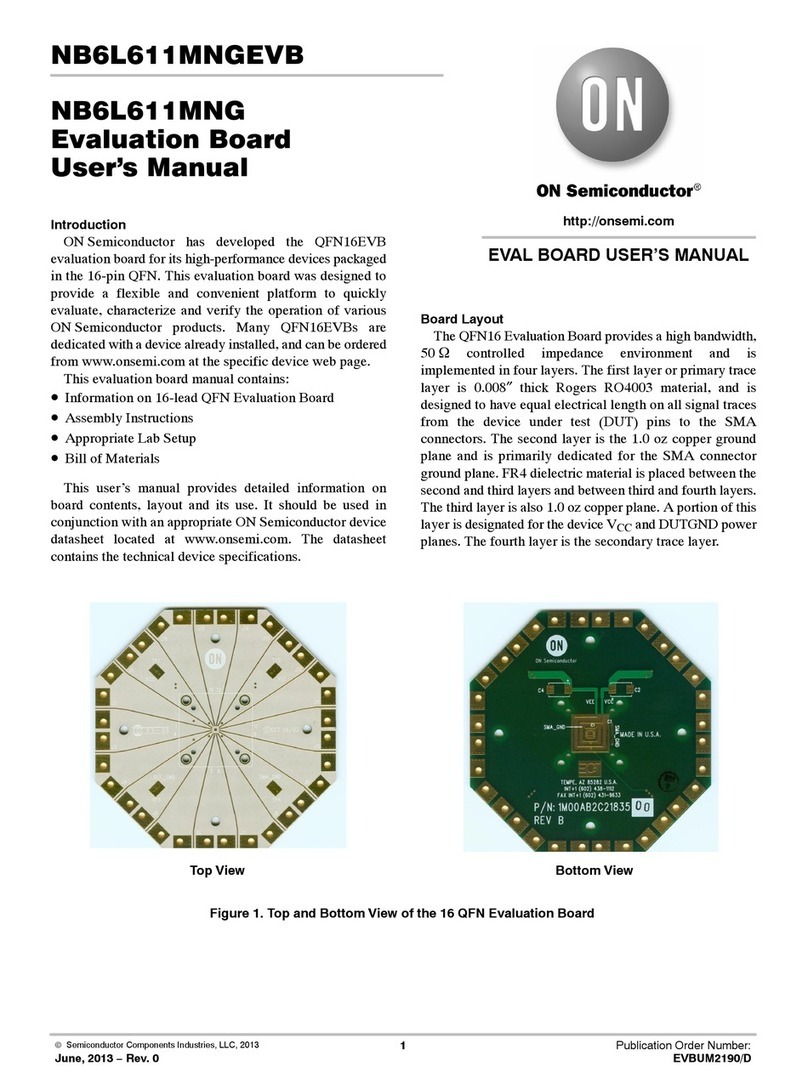
ECLTSSOP20EVB
http://onsemi.com
5
Evaluation Board Assembly Instructions
The 20−lead TSSOP evaluation board is designed for
characterizing devices in a 50 Wlaboratory environment
using high bandwidth equipment. Each signal trace on the
board has a via, which has an option of placing a termination
resistor depending on the input/output configuration (see
Table 1, Configuration List). Table 11 contains the Bill of
Materials for this evaluation board.
Solder the Device on the Evaluation Board
The soldering can be accomplished by hand soldering or
soldering re−flow techniques. Make sure pin 1 of the device
is located next to the white dotted mark and all the pins are
aligned to the footprint pads. Solder the 20−lead TSSOP
device to the evaluation board.
Connecting Power and Ground Planes
For standard ECL lab setup and test, a split (dual) power
supply is required enabling the 50 Winternal impedance in
the oscilloscope to be used as a termination of the ECL
signals (VTT = VCC – 2.0 V, in split power supply setup, VTT
is the system ground, VCC is 2.0 V, and VEE is –3.0 V or
–1.3 V; see Table 2, Power Supply Levels).
Table 2. Power Supply Levels
Power Supply VCC VEE GND
5.0 V 2.0 V −3.0 V 0.0 V
3.3 V 2.0 V −1.3 V 0.0 V
2.5 V 2.0 V −0.5 V 0.0 V
Connect three banana jack sockets to VCC, VEE, and GND
labeled holes. Wire bond the appropriate device pin pad on
the bottom side of the board to VCC and VEE power stripes.
(Device specific, please see configuration for each desired
device. See Figure 5)
It is recommended to solder 0.01 mF capacitors to C4 and
C5 to reduce the unwanted noise from the power supplies.
C1, C2, and C3 pads are provided for 0.1 mF capacitor to
further diminish the noise from the power supplies. Adding
capacitors can improve edge rates, reduce overshoot and
undershoot.
Termination
All ECL outputs need to be terminated to VTT (VTT = VCC
–2.0 V = GND) via a 50 Wresistor. 0402 chip resistor pads
are provided on the bottom side of the evaluation board to
terminate the ECL driver (More information on termination
is provided in AN8020). Solder the chip resistors to the
bottom side of the board between the appropriate input of the
device pin pads and the ground pads. For ease of assembly,
it is advised to place and solder termination resistors on its
vertical (side) position, instead of its original or flat position.
Installing the SMA Connectors
Each configuration indicates the number of SMA
connectors needed to populate an evaluation board for a
given configuration. Each input and output requires one
SMA connector. Attach all the required SMA connectors
onto the board and solder the connectors to the board on J1
through J20. Please note that alignment of the signal
connector pin of the SMA can influence the lab results. The
reflection and launch of the signals are largely influenced by
imperfect alignment and soldering of the SMA connector.
Validating the Assembled Board
After assembling the evaluation board, it is recommended
to perform continuity checks on all soldered areas before
commencing with the evaluation process. Time Domain
Reflectometry (TDR) is another highly recommended
validation test.































